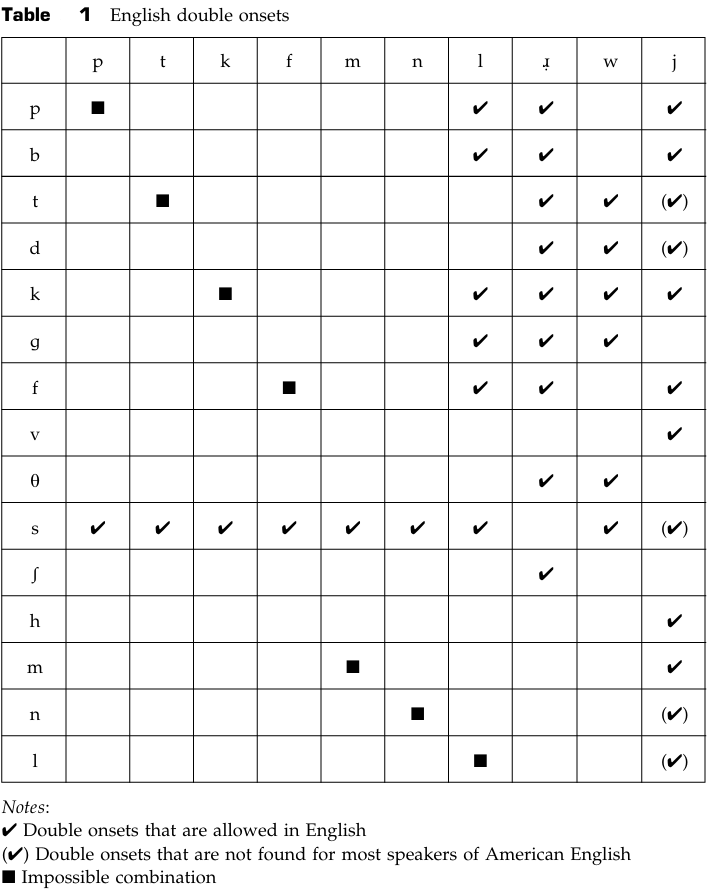


 Grammar
Grammar
 Tenses
Tenses
 Present
Present
 Past
Past
 Future
Future
 Parts Of Speech
Parts Of Speech
 Nouns
Nouns
 Verbs
Verbs
 Adverbs
Adverbs
 Adjectives
Adjectives
 Pronouns
Pronouns
 Pre Position
Pre Position
 Preposition by function
Preposition by function 
 Preposition by construction
Preposition by construction
 Conjunctions
Conjunctions
 Interjections
Interjections
 Grammar Rules
Grammar Rules
 Linguistics
Linguistics
 Semantics
Semantics
 Pragmatics
Pragmatics
 Reading Comprehension
Reading Comprehension|
Read More
Date: 2023-09-26
Date: 2024-05-13
Date: 2024-02-20
|
Double onsets
Table 1 shows the occurring double onsets of English. We can make the following observations. Affricates are the only class of consonants that do not appear in onset clusters. Besides this general statement, there are several other restrictions for two-member onset clusters:
• No voiced fricatives can serve as C2. Only /v/ can be a C1, and it can combine only with /j/ (e.g. view).
• No non-lateral approximant (/ɹ̣, w, j/) can serve as C1; the lateral can only precede /j/ (only for some speakers).
• No voiced stop can serve as C2.
• No fricative other than /f/ can serve as C2, and this can only be preceded by a /s/ in rarely found vocabulary (e.g. sphere).
• No stops or nasals are allowed as C2, except after /s/ (e.g. speak, small).
• /s/ and /ʃ/ are complementary: /s/ does not occur before /ɹ̣/, and /ʃ/ occurs only before /ɹ̣/ (e.g. shrimp).
• /h/ and /m/ can only occur before /j/ (e.g. huge, music).
• /θ/ can precede only /ɹ̣/ and /w/ (e.g. three, thwart).
• Labials (C1) do not cluster with a labial approximant.
• No geminates (i.e. doubled consonant sounds) are allowed.
• Alveolar stops (C1) do not cluster with /l/.

We can summarize the situation in the following manner. In general, English double onsets are either (a) /s/ +C (where C =any consonant that can assume the position of C2 except /ɹ̣/; /ʃ/ appears before /ɹ̣/), and (b) obstruent +approximant, with the limitations cited above.
While the pattern of C1 as an obstruent and C2 as a sonorant is very common, we do not have any double onset in which the reverse (C1 =sonorant and C2 =obstruent) is true. This pattern that we observe for English is also commonly found in many other languages, and can be accounted for by the principle known as ‘sonority sequencing’. We referred to sonority earlier for syllable peaks, and now we make reference to it for the sequencing of sounds with respect to a syllable peak by the Sonority Sequencing Principle (SSP). As given by Selkirk (1984: 116), SSP states that:
In any syllable, there is a segment constituting a sonority peak that is preceded and/or followed by a sequence of segments with progressively decreasing sonority values.
Thus, the expected pattern is that, going from C1 to C2, the sonority level will rise. Such is the case in the overwhelming majority of English double onsets (e.g. play[ple], cry[kɹ̣aɪ], quick[kwɪk]). The violations of this principle are /s/ +stop clusters (/sp, st, sk/), in which the sonority level drops, instead of rises, going from C1 to C2. As we will see with triple onsets as well as with double and triple codas, /s/ behaves exceptionally. To account for such cases, several scholars have suggested a special ‘adjunct’ status for /s/ clusters. We will not go into the details of such a proposal, but suffice it to state that this exceptional behavior of /s/ is also found in several other languages.
|
|
|
|
للعاملين في الليل.. حيلة صحية تجنبكم خطر هذا النوع من العمل
|
|
|
|
|
|
|
"ناسا" تحتفي برائد الفضاء السوفياتي يوري غاغارين
|
|
|
|
|
|
|
نحو شراكة وطنية متكاملة.. الأمين العام للعتبة الحسينية يبحث مع وكيل وزارة الخارجية آفاق التعاون المؤسسي
|
|
|